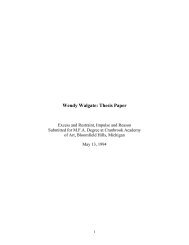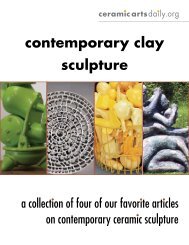Narrative Cycles on the Hagia Triada Sarcophagus - Wendy Walgate
Narrative Cycles on the Hagia Triada Sarcophagus - Wendy Walgate
Narrative Cycles on the Hagia Triada Sarcophagus - Wendy Walgate
- No tags were found...
You also want an ePaper? Increase the reach of your titles
YUMPU automatically turns print PDFs into web optimized ePapers that Google loves.
viewer (Fig 5). A seal from <strong>the</strong> Irakli<strong>on</strong> museum features an impaled, fr<strong>on</strong>t facing bull and a benttree which may have had <strong>the</strong> functi<strong>on</strong> of marking a sacred spot in relati<strong>on</strong> to sacrifice. On a goldring from Vapheio, <strong>the</strong> elements of female participant, a tree, a fr<strong>on</strong>t facing bucranium anddouble axe may be indicators of <strong>the</strong> life and death cycle (Fig 6). L Morgan suggests that “<strong>the</strong>dimensi<strong>on</strong> of renewed life is perceivable in many of <strong>the</strong> scenes of death in which fr<strong>on</strong>tal faceplays a role.” 32On <strong>the</strong> right, facing in a counter-clockwise directi<strong>on</strong> (H), a woman makes an offering infr<strong>on</strong>t of a stand or altar, which is decorated with an S-spiral pattern. L<strong>on</strong>g suggests that <strong>the</strong>purpose of <strong>the</strong> libati<strong>on</strong> cerem<strong>on</strong>ies, performed <strong>on</strong> both sides, was to obtain <strong>the</strong> favor of <strong>the</strong>deities in whose h<strong>on</strong>or it was performed and <strong>the</strong>reby to ensure for <strong>the</strong> deceased a safe journey to<strong>the</strong> afterworld. 33A black bird (I), which sits <strong>on</strong> top of a double axe with a slightly raised wing, is ready totake off in a clockwise directi<strong>on</strong>. On <strong>the</strong> far right is a structure, decorated with <strong>the</strong> S-spiralpattern, with four horns of c<strong>on</strong>secrati<strong>on</strong> <strong>on</strong> top and a vigorous tree growing up from <strong>the</strong> middle.The combinati<strong>on</strong> of <strong>the</strong> altar and structure may denote a significant site, but similar to <strong>the</strong> Northside, this image is not situated in a central positi<strong>on</strong> and placed <strong>on</strong> <strong>the</strong> far right of <strong>the</strong> South side.The tree is an obvious symbol of seas<strong>on</strong>al regenerati<strong>on</strong>. Marinatos suggests Minoan beliefembraced <strong>the</strong> cyclic symbol of <strong>the</strong> tree as a sacred object. She states, “its presence <strong>on</strong> <strong>the</strong>c<strong>on</strong>structed shrine sgnifies prosperity and <strong>the</strong> arrival of <strong>the</strong> divinity.” 3432 L. Morgan, “Fr<strong>on</strong>tal Face and <strong>the</strong> Symbolism of Death in Aegean Glyptic” (Corpus der minoischen undmykenischen Siegel Beiheft 5, 1995) 147.33 L<strong>on</strong>g, Ayia 68.34 N. Marinatos, “The Tree as a Focus of Ritual Acti<strong>on</strong> in Minoan Glyptic Art” (Corpus der minoischen undmykenischen Siegel Beiheft 3, 1989) 142.10





